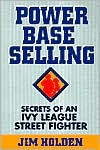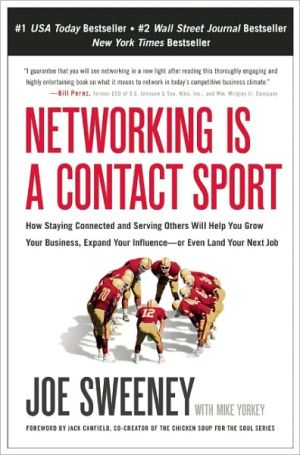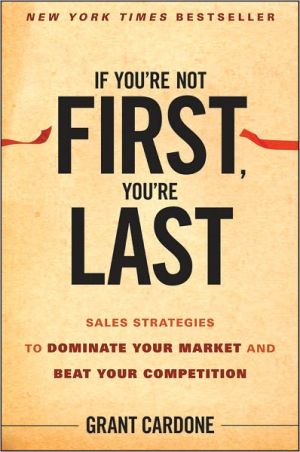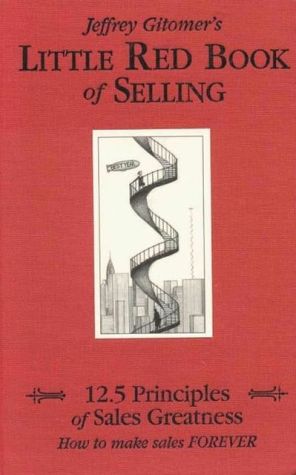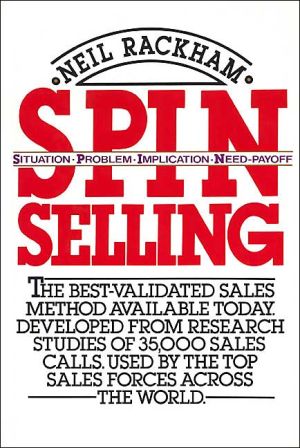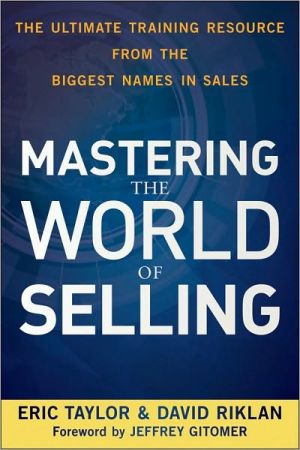Power Base Selling: Secrets of an Ivy League Street Fighter
"Holden's book is rich with wisdom and sage advice and should be required reading for any salesperson who wants to understand how to merge a sales strategy and a political strategy to win the hearts of their customers' Power Base."-Rodney D. Cotton, Vice President, Sales-United States, Baxter Healthcare, Renal Division.\ "Jim Holden's book is for serious salespeople and executives who are focused on winning. It provides insights, techniques, and everyday tools to reach the highest possible...
Search in google:
"Holden's book is rich with wisdom and sage advice and should be required reading for any salesperson who wants to understand how to merge a sales strategy and a political strategy to win the hearts of their customers' Power Base."-Rodney D. Cotton, Vice President, Sales-United States, Baxter Healthcare, Renal Division. "Jim Holden's book is for serious salespeople and executives who are focused on winning. It provides insights, techniques, and everyday tools to reach the highest possible level of success. The book is most insightful and is a required reading and work tool for enterprise salespeople and executives."-Grant Evans, Vice President, Sales and Marketing Identicator Technology. "The Holden Power Base Selling techniques have provided our sales teams with a common language from which to develop and plan strategies and tactics."- Colin Latham, President and CEO, MT&T (Canada). "Power Base Selling is essential. . . . The book is rich with lessons such as how to avoid being defeated by desperate 'end-games,' and how to 'snatch various victories from the jaws of defeat.' The conclusion is a revealing 'self-test.'. . . [Holden's] principles are more applicable today than ever."- Glenn W. Coleman, President, South Africa Branch, Lockheed Martin Overseas Services Corporation.
\ \ Chapter 5: The Direct Strategy: Making a Frontal Assault on the Competition\ Variation Three: Product Linking\ A third derivative of the direct strategy involves situations where you already have a strong presence in an account. As new sales opportunities arise with the customer, you may be able to gain competitive advantage simply because of the strength of your installation, even if your products have begun to lag somewhat in sophistication and capabilities.\ If you own a videocassette recorder, the odds are it's a VHS format machine. Now, imagine that. you decide to buy a second VCR, one to hook up to the television in your bedroom. When you go to your local customer electronics store, you find a VCR at a very good price that has some great new features. There's only one problem: it works in the Beta format. You can' buy this machine at a great price and get those terrific features, but you won't be able to use it to watch all the videotapes you already own.\ If you're like most people, you wouldn't buy this unit. Instead, you'd buy another VHS deck - even if its price may be a little higher - because the incompatibility between VHS tapes and a Beta deck defeats the purpose of convenience that set you on the buying path to begin with. There's a link between the product you'll buy and the one you already have.\ Beyond convenience, most business customers want to achieve a fairly high level of stability from the products and services they acquire from vendors. They want these products, in effect, to become invisible - to become such a normal, integral, and effortless part of their operation that they do not distract attention from the demands of business. So here you are, the incumbent vendor, and your customer is about to make an acquisition to expand their installation. Unless a competitor's product will be fully compatible with what you've already installed, with no cost to the customer in terms of conversion or retraining, you have a built-in advantage and can go direct by linking the buying decision to your existing installed base. All the tangibles are working in your favor.\ You also have intangible factors working for you. Even if an account is considering bringing in a niche vendor to solve a specific problem, the customer will be working with you on the bigger issues in the future. 'Mat's an important relationship, one the customer is equally responsible with you to protect. Senior managers in companies today more and more often recognize how the quality of their products can be improved by working with as few vendors as possible, and to establish strong relationships with the ones they rely upon. As long as your company markets a range and line of products that will serve disparate needs, you have a situation where your product mix will allow you to virtually own an account as it applies to the kind of solutions, you have to offer.\ In one of your accounts, if your company has been the established supplier for some time, and if no other company can offer a product that is compatible - and if this is critical to the customer - the choice for your strategy in new sales opportunities with them would very likely be the product linking variation of the direct approach. In all of your efforts, you would address the decision makers' expressed needs, but would also emphasize the positive aspects of "staying the course." From time to time, you would gently bring up the prospect of a disruption in the customer's operation should another vendor be brought in.\ Two things must be true for this version of the direct strategy to work for you. The first one is obvious: the customer must be satisfied with the product or service they've already received from you. After all, linking your sales efforts to a failed installation is roughly equivalent to celebrating having survived the Chicago fire by taking a cruise on the Titanic. The second requirement is that customers must conclude, perhaps reluctantly, that their attraction to another supplier isn't worth the drawbacks of having a multi-vendor environ-ment. If it's a toss-up, your presence in the account shouldn't lull you into thinking you have an edge....
Why Selling Skills and Good Products Are Not Enough.THE INSIDE TRACK.The Power Base: Finding the People with Influence.The Power Base Principle: How Value to the Company and Recognition Build Power.Foxes: Finding the Heart of the Power Base.Competing from Within: How to Develop Sales Opportunities.ENGAGING THE COMPETITION.The Direct Strategy: Making a Frontal Assault on the Competition.The Indirect Strategy: Pulling the Rug Out from under the Competition.The Divisional Strategy: How to Divide and Conquer the Competition.The Containment Strategy: Using "No-Decision" Tactics to Keep the Competition from Winning.Setting a Competitive Sales Strategy.Street Fighting Tactics for Keeping Competitors at Bay.The Political Strategy.ZEROING IN.Should I Compete?: Targeting Your Opportunities.Can I Win?Epilogue.Index.
